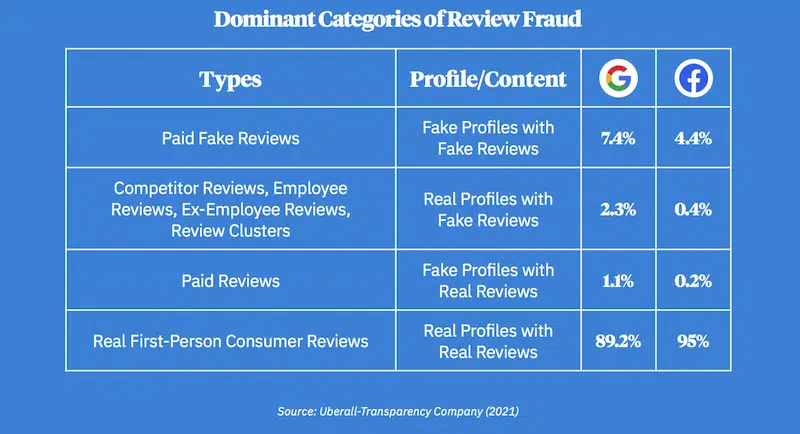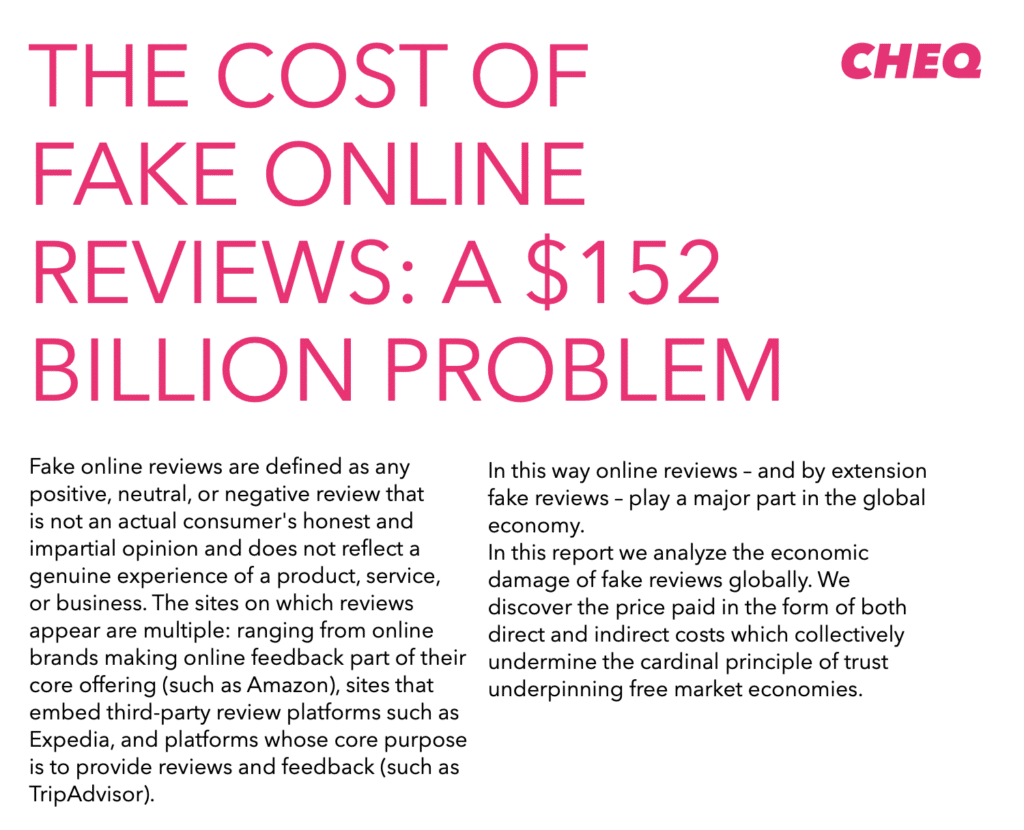You’re excitedly planning a weekend getaway, scrolling through review sites, and coming across a restaurant that everyone seems to love. You read rave reviews about their amazing food and fantastic service, picturing yourself enjoying a delicious meal in a vibrant atmosphere.
But what if that glowing feedback was more smoke and mirrors than reality? The rise of fake reviews is now becoming a growing concern, with every business vying for the top spot.
Just like how movie critics hold the power to sway public sentiments against or in favor of a movie at the box office, online reviews shape consumer decisions in everyday life. They serve as trusted guides, leading consumers to the best dining spots, software tools, gadgets, and experiences.
Yet, with technology making it easier to fabricate opinions, telling genuine feedback apart from fake, bought reviews and comments is now becoming a new challenge for consumers and businesses alike.
In this article, we’ll explore the state of fake reviews, starting with the methods used to create them, the statistics that reveal their prevalence, and the impact they have on consumer trust and businesses alike.
Methods of Creating Fake Reviews
Imagine you’re scrolling through a popular review site, looking for the perfect restaurant or the latest gadget. You come across a glowing review that raves about a product’s quality and service, but what if that review was completely fabricated?
With so much technology at hand, the between genuine feedback and deceitful tactics is increasingly blurred.
Here’s a breakdown of the most common methods for creating fake reviews:
- Paid review services: Some companies hire people or firms to write fake reviews for their products or services. These paid reviews often appear on platforms like Google, Yelp, or Amazon.
- Bots and automation: Many brands and even influencers use automated programs or bots to generate fake reviews and comments at scale. These bots can create numerous accounts and flood platforms with glowing reviews, often for a fraction of the cost of hiring real people.
- Fake accounts and personas: Some companies create fake accounts or personas that post positive reviews for their products while trashing competitors. These accounts may use stock photos or fake names to appear legitimate.
General Statistics and Trends on the State of Fake Reviews
Here’s a breakdown on prevalence of fake reviews online:
- Consumer awareness: Approximately 75% of consumers express concern about fake reviews, indicating a growing awareness of the issue. (Source)
This means a lot of customers are becoming more cautious when reading reviews and trying to spot what’s real and what’s not. Fake reviews are on people’s radar, and they’re starting to question what they see online before making a purchase.
People suspect fake reviews on Amazon and Facebook: About 49% of respondents feel certain they’ve come across fake reviews on Amazon, while 40% suspect they’ve seen them on Facebook. Google isn’t far behind, with 38% of people reporting they’ve noticed reviews that don’t seem genuine. (Source)

Consumers are becoming more aware and skeptical of the authenticity of reviews on major sites they use daily. If consumers become more wary of trusting reviews online, it will eventually affect their purchasing decisions.
- Fake review exposure is maximum among younger demographics: Around 80% of consumers reported encountering a fake review in the past year, with younger demographics (92% of those aged 18-34) more likely to identify these deceptive practices.
Clearly, younger generations are more aware of fake reviews and becoming pretty savvy at picking up on the telltale signs. They grew up in the digital age and are more comfortable navigating online spaces, so they’re quicker to recognize when something feels off.
This trend also suggests that brands might need to be extra cautious about misleading younger consumers since they’re increasingly less likely to fall for it.
Platform specificity: The highest percentage of fake reviews is found on Google (10.7%), followed by Yelp (7.1%), Tripadvisor (5.2%), and Facebook (4.9%).

Fake reviews are an issue across multiple platforms, but Google is seeing the highest percentage. This could be because it’s one of the first places people look when researching a business, so it becomes a prime target for those trying to manipulate public opinion.
Yelp and Tripadvisor also see their fair share, particularly in sectors like restaurants and travel, where reviews can make or break a business.
While Facebook is lower on the list, it is still significant. Given its massive user base and integration into daily life, even a small percentage of fake reviews can have a big impact.
- A crackdown by the U.S. Federal Trade Commission (FTC) on fake reviews: In response to the growing issue, the U.S. Federal Trade Commission (FTC) has tightened regulations, proposing fines for companies involved in creating or disseminating fake reviews. (Source)
FTC Chair Lina Khan put it perfectly when she said,
“Fake reviews not only waste people’s time and money but also pollute the marketplace and divert business away from honest competitors.”
This is a big deal because fake reviews can mislead consumers into making poor purchasing decisions, while genuine businesses suffer as a result.
So, what’s the FTC doing? They’ve put together a final rule that tackles several key issues surrounding fake reviews:
- Fake Reviews: No creation or purchase of fake consumer reviews, including AI-generated ones.
- Paid Reviews: Companies can’t pay for positive or negative reviews.
- Transparency: Review writers must disclose any close connections to the business.
- Independent Reviews: Businesses can’t falsely claim that controlled review sites are independent.
- Review Suppression: Companies can’t intimidate customers to remove negative reviews.
- Fake Social Media Influence: Buying or selling fake followers/likes is prohibited.
This move is all about making online shopping safer and more trustworthy for everyone.
Consumer Awareness and Trust
- Influence of online reviews: Approximately 66% of U.S. consumers state that they are “frequently” or “very frequently” influenced by customer reviews during their purchase journey. (Source)
Think about it—whether you’re choosing a restaurant for dinner, buying a new gadget, or booking a hotel, you’re likely to check out what others have said about it first.
This trend shows just how much weight people place on others’ experiences. Consumers trust reviews almost like a friend’s recommendation, even when it’s from strangers! With so many options out there, reviews give them that sense of reassurance.
So, if a product has tons of positive feedback, they’ll feel confident about purchasing it. On the flip side, a few negative reviews can quickly make them second-guess their choice.
Growing confidence in consumer-generated content: The percentage of consumers who trust online reviews as much as professionally written articles has increased by 4% from 2023 to 2024, indicating a growing confidence in consumer-generated content despite the prevalence of fake review.

Despite the ongoing issue of fake reviews, genuine feedback from fellow consumers still remains valuable. People likely appreciate the real-life insights that online reviews provide, which can feel more relatable than polished articles created by companies or marketers.
Financial Impact of Fake Reviews on Businesses
- Estimated global revenue loss due to fake reviews: Fake reviews cost U.S. businesses nearly $152 billion annually due to reputational damage and lost sales opportunities. (Source)

When customers read fake reviews, they might feel misled or distrustful, which can lead them to avoid a brand altogether. Imagine you’re shopping online and see a product with glowing reviews, but later, you find out those reviews were fake. That negative experience can stick with customers and impact their future buying decisions.
Plus, businesses spend a lot of time and money building their brand image. If fake reviews tarnish that image, it can take a long time to rebuild trust with customers. You may find yourself spending more on marketing and customer service just to regain your standing.
- Percentage of businesses impacted: Over 50% of consumers say that they won’t purchase a product if they suspect that the consumer feedback is fake. (Source)
It’s safe to say that skepticism over fake reviews translates into real life drastically and can impact sales for businesses that rely on online reviews to attract customers.
Future Predictions and Trends
- Expected growth in fake reviews: In 2023, Tripadvisor reported blocking a record 2 million fake reviews, which accounted for 6.3% of total submissions that year, marking a 50% increase from the previous year. (Source)
This trend suggests that fake reviews are becoming a bigger problem, not just for Tripadvisor but across various platforms. As more businesses realize how powerful online reviews can be, some may resort to unethical practices to boost their ratings.
For consumers, this means that we need to be more cautious when reading reviews. Even if a restaurant or hotel seems to have glowing feedback, it’s worth doing a little more digging.
Conclusion: Challenges of Fake Reviews for Business Success!
This rise in fake reviews can cause a great damane to both the reputation and revenue of a business. With around 75% of consumers expressing concerns about fake feedback, the trustworthiness of online platforms is under scrutiny, and businesses risk alienating potential customers if they’re seen as part of the problem.
Consumers are also getting smarter and more perceptive—especially the younger generation—at gauging fake reviews. This shows that rather than investing in fake reviews and comments, it’s better to invest in customer experience and satisfaction to garner actual positive feedback.
If consumers suspect that feedback is fraudulent, over 50% are likely to avoid making a purchase altogether. This means that companies not only face the repercussions of lost sales but also the daunting task of rebuilding trust, which can be time-consuming and costly.
On top of that, even government bodies like the FTC have also announced penalties for fraudulent practices.
Safeguarding the authenticity of feedback is essential for long-term success. Ultimately, by addressing the challenges posed by fake reviews head-on, businesses can protect their brand reputation, foster consumer trust, and drive sustainable growth.



